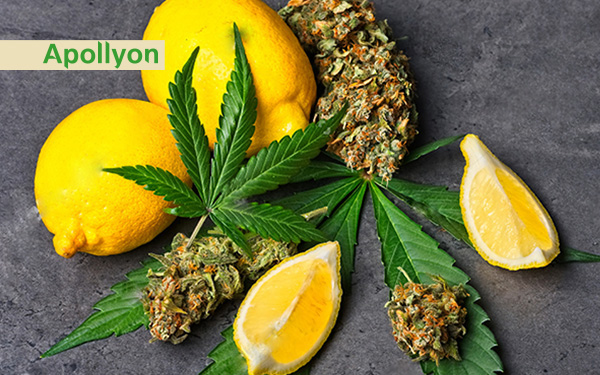Want to buy terpenes? Wide choice of pure terpenes and terpene products!
You can now buy terpenes online in our extensive healthshop as well. We do not only offer these important and extremely beneficial plant ingredients as pure terpene isolates, but also as complete terpene profiles as these can be found in a particular cannabis plant.
What are terpenes?
Terpenes, also known as isoprene derivatives, are derived from plants and can be found as natural ingredients in countless plants, including in cannabis plants (hemp and weed) as well. This large group of organic molecules, which are produced naturally in plants, can in exceptional cases also be derived from animals, as has been observed in some insects like termites and a few caterpillar/butterfly species.
Some caterpillars for instance can extend a forked organ (osmeterium) when danger threathens, which wards off enemies by the strong smell of the terpenes released. Some water beetles also possess the ability to be able to excrete certain terpenes which can drive off harmful predators.
Strong smelling aroma of terpenes
Terpenes, which are known for the strong smelling aroma they produce, offer a protective ability for plants. The strong scents can drive off harmful bacteria, fungi, plant eaters (herbivores) and other unwanted visitors, so they do not damage the plant.
Instead of scaring off the natural enemies of the plant, the scent of certain terpenes can also cause useful insects to be attracted. This can be of major importance for the cross-pollination of plants. Besides this important function they offer many other useful biological functions, including for example protection against intense sunlight.
Terpenes are beneficial for both plants and humans
Besides terpenes making sure plants can stay healthy, terpenes can also have many useful applications like scent- and aromatic substances, but also in essential oils and cosmetics, where it for instance improves the absorption of skin lotions. Hemp- and weed plants also hold large concentrations of these beneficial terpenes and therefore offer many benefits.
Difference between a terpene, terpiniol and terpenoid
Terpiniols (alcohols) and terpenoids (isoprenoids) are derivative groups of terpenes. Contrary to terpenes, which are made up of only carbon and hydrogen (single bond hydrocarbons), they have additional functional compounds paired with alcohol, aldehyde or ketones. The three terms are often used interchangeably.
Terpenes belong to the largest group of plant components
Terpenes belong to the largest group of plant components by far and researchers have by now identified 48,000 structures, of which 8,000 are categorised as terpenes and 40,000 as terpenoids. Despite that all these structures are varying in nature, they all have the same basic precursor. This organic precursor, which is known as isopentenyl diphosphate, or IDP for short, consists of five carbon atoms and is formed from acetic acid.
Classification of terpenes
The classification of terpenes is done on the basis of the number of carbon atoms from which they are constructed. This is indicated with the letter C. The prefix which is present in the names, is based on the number of terpene units with which the molecule is constructed. So for instance the hemiterpenes belong to the half terpenes with five carbon atoms (C5) and the word 'mono' in monoterpenes stands for the number 1. 'Sesqui' stands for 1.5, 'di' for 2 and 'tri' for 3.
- Hemiterpenes (C5)
- Monoterpenes (C10)
- Sesquiterpenes (C15)
- Diterpenes (C20)
- Sesterterpenes (C25)
- Triterpenes (C30)
- Sesquarterpenes (C35)
- Tetraterpenes (C40)
- Polyterpenes (>C40)
Mono- and sesquiterpenes are an important ingredient of the essential oil which plants posses, while terpenes that have a higher number of carbon atoms can mainly be found in resin, wax and rubber. An example of this is isoprene rubber, a polyterpene with over forty carbon atoms.
An example of a tetraterpene with 40 carbon atoms is β-carotene (beta-carotene), a well-known ingredient of carrots. Known examples of monoterpenes with 10 carbon atoms are myrcene, pinene and sabinene, which all three can be found in cannabis. Myrcene is furthermore a well-known ingredient in hop, pinene in pine resins and sabinene in chamomile as well.
What is the biological function of mono- and sesquiterpenes?
Mono- and sesquiterpenes, which are characterised by their powerful aroma, make up a beneficial ingredient in the essential oil from plants. This volatile oil, which is produced in various parts of the plant, gives off an overpowering scent that can be released by heat amongst other things.
This characteristic smell of the terpenes envelops the plant like a haze which repels all kinds of unwanted enemies like fungi, parasites, bacteria and harmful insects. Specific scents of terpenes can furthermore also have the rather opposite function of attracting beneficial insects. For instance some insects which are of importance for the cross-pollination of the plant, actually find a particular scent very pleasing and are drawn to it.
The scent of a terpene can also act as an aid in a possible attack from an unwelcome visitor. By giving off a particular scent during an attack, a natural enemy of the unwanted intruder is alerted, which means the intruder can be neutralised in time and major damage to the plant can be prevented.
Long history in health care
Despite researchers having identified a large group of terpenes only fairly recently, the Chinese have known that the essential oils in plants and herbs posses many beneficial properties for healthiness since well before 3000 BC.
Essential oils have been used for health promoting purposes since ancient times. The true masters in applying these beneficial oils were the ancient Egytians, who were closely monitored by all kinds of interested physicians from far and wide, which wanted to study the effects.
In a 12th century writing Arnaldus de Villa Nova describes the distillation of an extract from sage and rosemary. The oil this produced he called oleum mirabile (miraculous oil). Also in 1950 over 60 different essential oils were described in the Nuremberg edition of the Dispensatorium Valerii Cordi as well.
Beneficial effects of terpenes
Nowadays essential oils still play a very important role and they are applied on a large scale in the food- and nutritional industries and are an important ingredient in cosmetics, including perfumes and creams.
Additionally they are of great value in traditional medicine and alternative herbalism, like for example in aromatherapy and extensive research is being performed on the characteristics of terpenes.
For instance studies have determined that certain terpenes from plant extracts which have been added to skincare products, like for example ointments, skin oils, balms or massage oils, have the beneficial characteristic of making it easier for other active ingredients to better permeate the skin. Due to this deeply penetrating effect a very effective uptake becomes possible.
Beneficial terpenes in hemp and weed
Just like the cannabinoids which are found in these plants from the cannabis genus, terpenes which are present in hemp and weed possess various useful characteristics. A major difference between the two is that cannabinoids are almost exclusively to be found in cannabis plants (and only in a very few other plants) and terpenes are present in thousands of different species of plants and herbs.
Some researchers hypothesize an important cooperation between terpenes and phytocannabinoids
Amongst various weed- and hemp researchers the suspicion exists that terpenes can influence the effects of phytocannabinoids. They call this moderating effect the entourage effect. The entourage effect would also explain why for instance a Sativa weed strain with an equally high THC-level as an Indica strain still has a different effect. Although promising, this effect has yet to be confirmed through clinical research.
Well over 120 types of terpenes in cannabis
By now at least 120 different terpenes have been identified in cannabis. These terpenes have been found in the sticky resin glands of plants, also called trichomes. Not every cannabisplant contains the same concentrations and relative proportions, this differs for each plant. The formation of terpenes is influenced by all kinds of environmental factors, like for instance the climate, the soil condition or the age of the plant.
The time of day also matters for the amount of terpenes present. Due to the volatile oils from the plant evaporating through heat, the plant will have less terpenes present at the end of the afternoon than it will have early in the morning.
Terpene profile in cannabis plants
Cannabis plants often contain a large concentration of ß-caryophyllene or BCP for short. This sesquiterpene plays a very major part in determining the scent and taste of the plant. Other terpenes, terpineols and terpenoids which can be found in hemp- and weed plants are myrcene, limonene, linalool, pinene, borneol, phytol, nerolidol, cineol (eucalyptol), carene, pulegon, sabinene, terpineol, humulene and caryophyllene oxide.
The most well-known terpenes, terpineols and terpenoids which can be present in cannabis, are discussed at length in the clickable links below. Besides an extensive description of the terpene in question, the beneficial effects are listed as well.
Buy terpenes easily online at Apollyon
At Apollyon Smartshop Rotterdam you will find a large selection of headshop-, smartshop-, healthshop and seedshop products. It's easy to buy online and while doing so you can benefit from:
- Free shipping above 49 euro
- Ordered before 16:00, shipped the same day
- Best selection in the Benelux
- Ordering safely in a secure payment environment



























